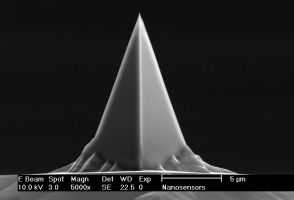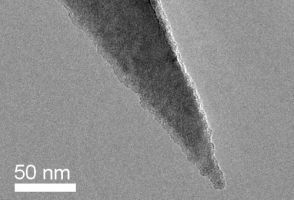PointProbe® Plus Non-Contact /Tapping Mode - Long Cantilever - Au coating
The PointProbe® Plus (PPP) combines high application versatility and compatibility with most commercial SPMs. The typical AFM tip radius of less than 7 nm and the minimized variation in AFM tip shape provide reproducible images and enhanced resolution.
NANOSENSORS™ PPP-NCLAu probes are designed for non-contact mode or tapping mode AFM (also known as: attractive or dynamic mode). The NCL type is offered as an alternative to NANOSENSORS™ high frequency non contact type (NCH). PPP-NCLAu is recommended if the feedback loop of the microscope does not accept high frequencies (400 kHz) or if the detection system needs a minimum AFM cantilever length > 125 µm. Compared to the high frequency non-contact type NCH the maximum scanning speed is slightly reduced. This AFM probe type combines high operation stability with outstanding sensitivity and fast scanning ability.
The AFM probe offers unique features:
- metallic conductivity of the AFM tip
- AFM tip height 10 - 15 µm
- Au coating on both sides of the AFM cantilever
- chemically inert
A metallic layer (Au) is coated on both sides of the AFM cantilever. The tip side coating enhances the conductivity of the AFM tip and allows electrical contacts - the typical AFM tip radius of curvature is less than 50nm. The detector side coating enhances the reflectivity of the laser beam by a factor of 2.5 and prevents light from interfering within the AFM cantilever. The coating process is optimized for stress compensation. As the coating is nearly stress-free the bending of the AFM cantilever due to stress is less than 2 degrees.
Please note: Wear at the AFM tip can occur if operating in contact-, friction- or force modulation m
This AFM probe features alignment grooves on the back side of the holder chip. These grooves fit to the NANOSENSORS Alignment Chip.








